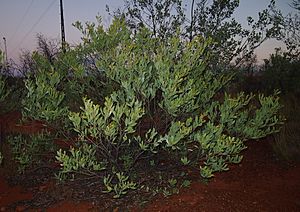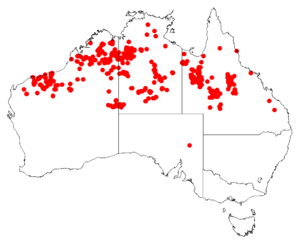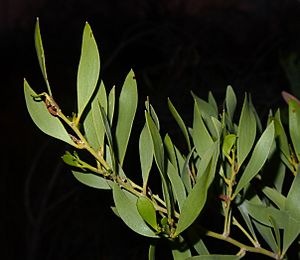Velvet Hill wattle facts for kids
Quick facts for kids Velvet Hill wattle |
|
|---|---|
 |
|
| Scientific classification | |
| Genus: |
Acacia
|
| Species: |
acradenia
|
 |
|
| Occurrence data from Australasian Virtual Herbarium | |
Acacia acradenia, often called the Velvet Hill wattle or silky wattle, is a type of shrub or tree. It belongs to the Acacia family, which is a very common group of plants in Australia. This plant grows naturally in northern and central Australia. Different Indigenous Australian groups have their own names for it. For example, the Nyangumarta people call it walypuna, and the Warlpiri people know it as ngardurrkura.
Contents
What Does It Look Like?
This tree or shrub usually grows to be about 0.9 to 4 meters (3 to 13 feet) tall. Sometimes, it can even reach up to 7.5 meters (25 feet)! It often has a V-shape, looking open and sometimes a bit thin. Its main stems usually split from the ground, growing straight or spreading out. The bark is smooth and light grey, but near the bottom, it can have long cracks.
Instead of typical leaves, Acacia acradenia has special leaf-like parts called phyllodes. These phyllodes are usually shaped like a narrow oval, getting thinner at both ends. They can be 4 to 16 centimeters (1.6 to 6.3 inches) long and 10 to 40 millimeters (0.4 to 1.6 inches) wide. They have many lines running along them.
The plant can bloom (produce flowers) at any time of the year, but it flowers most often between March and July, and again in October and November. It produces beautiful yellow flowers. These flowers grow in spikes, which are like long clusters. Each flower spike is 2 to 7 centimeters (0.8 to 2.8 inches) long and packed with bright golden flowers.
After the flowers bloom, many seed pods form. These pods hang down and are straight or slightly curved. They are narrow and linear, about 4 to 11 centimeters (1.6 to 4.3 inches) long and 2.5 to 4 millimeters (0.1 to 0.2 inches) wide. Inside these pods are shiny brown seeds, which are about 4 to 5 millimeters (0.16 to 0.2 inches) long.
This plant doesn't live for a very long time. Fires can easily kill it, but its seeds are good at sprouting and growing new plants after a fire.
How Scientists Name It (Taxonomy)
The first time this plant was officially described was in 1888 by a botanist named Ferdinand von Mueller. He wrote about it in a book called Iconography of Australian Species of Acacia and Cognate Genera Decas.
Later, in 1987, another scientist named Leslie Pedley reclassified it. But then, in 2006, it was moved back to the Acacia group. The scientific name acradenia comes from two Greek words: acron, meaning "tip," and adenos, meaning "gland." This name probably refers to a small gland-like point at the tip of its phyllodes.
Where Does It Grow? (Distribution)
You can find Acacia acradenia across the Northern Territory and stretching east into Queensland. It also grows in Western Australia, especially in the Kimberley, Pilbara, and northern Goldfields areas.
This wattle likes to grow on rocky plains, rocky hills, and along watercourses or damp areas. It does well in stony soils, thin soils, or clay pans. It often grows alongside spinifex grasses and Eucalypt trees. After events like fires, new groups of these plants can grow in those disturbed areas.
How People Use It
Indigenous Australians have many uses for Acacia acradenia. They use it as a source of food and water. It also provides shade and shelter. In addition, they use parts of the plant to make weapons and other tools.


